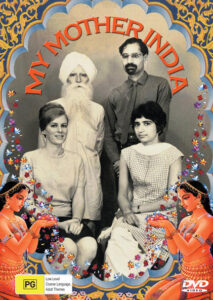Written and directed by Safina Uberoi
Produced by Penelope McDonald
VHS. Color. 52 minutes. Chili Films, 2001
Reviewed by Asiya Malik
 My Mother India weaves together the experiences of one family over three generations, the past with the present, 1947 with 1984, Australia and India. Written and directed by Safina Uberoi, this documentary begins as a hilarious account of a marriage between an Australian woman named Patricia, and Jit, an Indian-Sikh man—Uberoi’s parents. They fell in love and married in Canberra but decided to settle in India. Uberoi paints a colorful picture of her childhood and her multi-cultural upbringing in New Delhi by discussing her parents’ notorious kitsch calendar collection and how her mother Patricia, because of her foreign upbringing, causes scandals in the neighborhood when she hangs her underwear out to dry. Uberoi’s family proves even more atypical when we learn that her grandparents eloped and, after several years of marriage, were divorced in 1950. Her grandfather, Papa-ji, was a guru, while her opinionated grandmother, Bijee, with whom one cannot help but fall in love, is a feminist who openly declares, “all men are bastards.”
My Mother India weaves together the experiences of one family over three generations, the past with the present, 1947 with 1984, Australia and India. Written and directed by Safina Uberoi, this documentary begins as a hilarious account of a marriage between an Australian woman named Patricia, and Jit, an Indian-Sikh man—Uberoi’s parents. They fell in love and married in Canberra but decided to settle in India. Uberoi paints a colorful picture of her childhood and her multi-cultural upbringing in New Delhi by discussing her parents’ notorious kitsch calendar collection and how her mother Patricia, because of her foreign upbringing, causes scandals in the neighborhood when she hangs her underwear out to dry. Uberoi’s family proves even more atypical when we learn that her grandparents eloped and, after several years of marriage, were divorced in 1950. Her grandfather, Papa-ji, was a guru, while her opinionated grandmother, Bijee, with whom one cannot help but fall in love, is a feminist who openly declares, “all men are bastards.”
The film is narrated by Uberoi and consists of a compilation of interviews with different members of her family about their lives and experiences in India. The documentary takes on a more somber tone when Uberoi turns to the events of 1984. Her family’s peaceful existence is destroyed when Hindu-Sikh tensions begin to escalate. Papa-ji, diagnosed with Alzheimer’s, begins to revisit his past. His daughter-inlaw Patricia, Papa-ji’s caretaker during his final days, discusses how Papa-ji begins to lovingly reminisce about the early years of his marriage to Bijee. Even though Papa-ji is on his deathbed, Bijee refuses to visit or forgive him for the emotional agony he caused her while they were married, including the time when he almost deserted her after she had miscarried a baby just after they escaped to India from Lahore in 1947. Talk of the curfews and communal riots surrounding Hindu-Sikh tensions in 1984 also rekindles Papa-ji’s memories of the curfews enforced in Lahore before partition and before the deadly violence of 1947 began. Ironically, by his revisiting and reenacting the past, the past comes alive in the present. Uberoi adds, “As he went mad, it seemed as if the whole state of Punjab was mirroring his insanity.”
Uberoi discusses the political instability in India in 1984, when tensions between Sikh extremists and Prime Minister Indira Gandhi’s government began to mount in the Punjab. Sikh extremists were demanding the creation of a separate Sikh state of Khalistan. With no peaceful solution in sight, in June 1984 the Indian government implemented Operation Blue Star—a military operation intended to restrain and remove Sikh extremists who had taken up refuge in the Golden Temple in Amritsar. In the battle that ensued, hundreds of Sikhs and Indian military personnel were injured or killed. Sadly, Papa-ji’s funeral took place in the context of these turbulent days. For the following several months, the aftershocks of Amritsar vibrated throughout India with deadly resonance. When Indira Gandhi’s Sikh bodyguards assassinated her on October 31, the Uberoi family was at their family home in New Delhi. Vengeful and bloodthirsty mobs demanding Sikh lives roamed the streets of the city, and the Uberois were forced to flee from their home.
The events of 1984 literally tear the family apart as some members gradually begin to move to Australia. Everyone in the family is forced to reassess who they are and how they are perceived in India. Patricia discusses how Jit’s ideal of India is destroyed when he realizes that he is not considered an Indian, but a Sikh. After decades of living in India, Patricia too feels alienated and is forced to decide where her home is. Uberoi and her siblings fight their own battles with identity; Uberoi reclaims her Sikh heritage, her brother Prem is compelled to move to Australia, and her sister, on moving to Australia, changes her name from the Indian name of Simeran to the Greek name of Zoe.
Produced by Chili Films, this acclaimed film is a winner of numerous awards including the Jury Prize for Best Australian Documentary, Australian Film Critics Circle; Best Australian Documentary, Real Life on Film Documentary Festival; and Best Long-Form Documentary Australian Teachers of Media Award. It is highly recommended for high school and college students engaged with Indian history, issues of religion, identity, transnational cultural politics, and cultural diversity. This powerful film moves beyond just being a commentary on the events of 1947 and 1984. A personal story that almost anyone can relate to at some level, it is about happiness, love, marriage, betrayal, hardship, sorrow, spirituality, loss, and bitter hatred. Given the ethnic and religious tensions pervasive in India, the strength of this film ultimately lies in its ability to move beyond the traditional Hindu-Muslim dichotomy popular in literature and films on India, and raise an even more profound and complex question of what it means to be an Indian.

